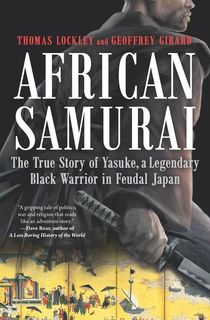Samurai are the most iconic historical warriors to come out of Asia, or perhaps the entire world. An Eastern counterpart to the European knight, this preeminent noble soldier figure has dominated literature and culture for centuries, from prose and poetry to film and television. In the 16th century, legendary feudal lord Oda Nobunaga had a particularly special samurai in his court: an African man whom they called Yasuke, one of the first Black men in Japan.
Much of Yasuke’s life remains a mystery. His country of origin has never been confirmed, but there are a few theories. A 17th-century account says he was most likely from Mozambique, and while there is no direct evidence to back up this claim, the first Africans to reach Japanese shores are indeed thought to have been Mozambican. Modern theories suggest he could have been a member of the Yao people of northern Mozambique.
Related: Fact or Fantasy: All About Female Samurai Warrior Tomoe Gozen
That could account for the name given to the samurai: Yao combined with -suke, a common suffix for Japanese male names. Others suggest that Yasuke could have been Ethiopian, Nigerian, or a member of the Dinka people of South Sudan.
What we do know is that Yasuke arrived in Japan in 1579. He was in the company of an Italian Jesuit missionary named Alessandro Valignano, likely as a bodyguard and servant; some suggest he was a slave, but his skill in battle makes it more likely that he was a warrior by trade. Valignano was in charge of inspecting the Jesuit missions in East Africa, South, Southeast, and East Asia. In 1581, Valignano traveled to the then-capital of Kyoto to meet with Oda Nobunaga.
Nobunaga took an interest in the physically imposing Yasuke, who stood at six feet, two inches tall—about a foot taller than the average Japanese man at the time—with a strong physique. Having never seen a Black man before, the daimyo asked for Yasuke to be scrubbed, thinking his skin was dyed with ink. Fascinated by his appearance, Nobunaga bestowed the African man with a gift of money, threw a party to welcome Yasuke into his court, and seeing that he was knowledgeable with weapons, entered Yasuke into his service as a samurai.

Portrait of Oda Nobunaga.
Photo Credit: WikipediaTales of a man with black skin in the service of the daimyo swept through Kyoto. Legend has it that the populace was so eager to get a look at the man that some were trampled to death in the stampedes to spot the samurai. Yasuke likely already had some knowledge of Japanese by that point, and he soon became a trusted confidant of the feudal lord. The African man conversed regularly with Nobunaga, the daimyo finding his samurai as skilled with language as he was with the sword. As the samurai’s Japanese improved, Yasuke entertained Nobunaga with tales of Africa and India, where he most likely traveled with Valignano.
Related: Viking Myths: Separating Fact from Fiction
A painting likely depicting Nobunaga watching a sumo match features a dark-skinned wrestler, presumably Yasuke. The daimyo was famously a sumo fanatic, and this would have endeared the African to him even more. Nobunaga, who liked to surround himself with the disciplined and intelligent and was a patron of the arts, also appreciated when Yasuke performed Utenzi, traditional Swahili poetry. The samurai was permitted to dine with Nobunaga, one of the most exclusive honors the daimyo could bestow.
The two were together until the end. In 1582, general Akechi Mitsuhide betrayed his superior, ambushing the woefully outnumbered Nobunaga at the Honno-ji temple. With no hope of victory, Nobunaga committed Seppuku, ritual suicide that involves slicing the abdomen. Tradition has it that Yasuke either committed the beheading that follows Seppuku or was entrusted with the severed head, both high honors reserved for the departed’s closest friends. It was crucial that Mitsuhide did not grab hold of the head, as displaying Nobunaga’s remains would legitimize Mitsuhide's rule.
Related: Black Patriots and Loyalists: An Untold Story of the Revolutionary War
Oda Nobutada, the daimyo's son, was the next to be attacked, and he followed his father by committing Seppuku. Yasuke was captured soon thereafter, and may have been exiled to the Jesuit mission in Kyoto. Mitsuhide was later defeated, unable to gather the support to become the strong ruler Nobunaga was. Yasuke completely disappears from the written record after the death of Nobunaga and his son.

Still from the Netflix anime 'Yasuke'.
Photo Credit: NetflixYasuke has captured the public imagination for decades. A Japanese children's book from the 1960s called Kuro-suke is largely based on Yasuke’s life and relationship with Nobunaga. He has made regular appearances in period manga, anime, and video games, many of which weave in elements of fantasy.
Afro Samurai, a stylistic kung fu anime starring Samuel L. Jackson, was inspired by the African samurai. Just this year Netflix released Yasuke, a fantasy anime that follows Yasuke 20 years after the death of Nobunaga, featuring plenty of flashbacks that reveal the betrayal of the daimyo, his suicide ritual within the burning temple, and more. Film studio MGM is reportedly working on a film about Yasuke. Picturestart was also working on a film about the samurai, but the project's status is unclear after the death of Chadwick Boseman, who had signed on to portray Yasuke. Over 400 years after he vanished from the history books, this mysterious figure—the first foreigner in Japan to achieve the status of samurai—still fascinates us more than ever.

